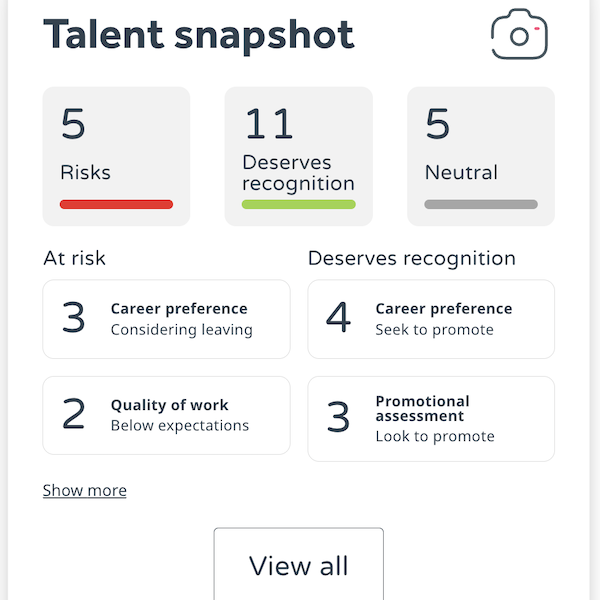In four words: Disengagement costs you money
It’s odd that a thing as nebulous as poor engagement costs money, but it does – according to Forbes report on the cost of low engagement, Gallup on employee engagement has calculated that organisations with a high ratio of engaged employees experienced 147% higher earnings per share than their competition. Low engagement costs you via lost productivity, lost quality, lost working time through sickness and inattention, employee retention problems and, in the end, lost customers. But if engagement is nebulous how do you know which staff have lost it? Here are seven sad signs… (oh, and an easy way to find out who is suffering from what, so you can fix it).
1: They’re not delivering
This is the most obvious sign of disengagement, as seen from the top of the company – productivity dips. Now, if people slow down you can be sure something has happened to upset them, so if some of the team are doing less, or are working less diligently, or the quality goes off, it’s time to find out what’s up before it spreads… However, even when the team is in good form, some people will be doing a lot better than others. You can’t eradicate this spread altogether – some people just are more highly driven than others – but you can narrow the gap and give everyone a chance to achieve more of their potential and get more satisfaction out of their working life. This means work has to meet the innate psychological needs of the human being, because people get frustrated and lose drive when those needs aren’t met. You can go into this in more detail, or simply use WeThrive to get things running smoothly.
2: They’re not smiling
Of course you want the staff to concentrate, not just sit there grinning, but if the mood of the office goes sour you can be sure they won’t be engaged in their work. Somewhere between happily relaxed and grim-faced determination there is a sweet spot, a place where people are focussed and stimulated but not overwhelmed. In this zone you will see the occasional smile, which is a good thing – it shows that people are able to relax periodically. That doesn’t mean they’re slacking – the smiles come between the bouts of concentration, and you can’t (sustainably) have one without the other. But if there are no smiles in the office the staff won’t stay if they can help it.
3: They’re not collaborating
Getting a bunch of individuals to become a team is not easy – and, with a very few exceptions, it won’t happen at all if they are under too much of the wrong kind of pressure. This is because as stresses increase the old survival templates kick in and people become more individualistic. In fact, if things get bad enough people lose awareness of everything except themselves. This is the root of the ‘silo’ mentality – it is an attempt to preserve the prospects of an individual at the expense of the rest of the group. It only happens because that individual’s working life is not as it should in the first place, and it corrodes the efforts of the whole team. Competitiveness for the company demands the enhanced mental power that results from collaboration between people. This means they have to share – so they’ll have to feel that it is safe to do so. Get the culture and environment of the workplace right and it won’t be a problem – but how will you know if that’s the case?
4: They’re not innovating
It’s a hard world out there and keeping ahead of the competition demands a constant flow of new ideas. However, innovation, experimentation, imagination – all the faculties that allow new things to emerge – are hobbled if the social and emotional conditions in the workplace aren’t right. Daniel Kahneman explained why in his best-selling book, “Thinking Fast and Slow” – insecure, stressed people seek safety, which they won’t find by trying something unknown. However, excitement can trigger innovation when the brain was previously feeling calm and secure. Professor Kahneman says the key is positive reinforcement: “encouragement, respect, and enhanced responsibility”. So if your people are sticking to the old routines while the world accelerates away, here’s a good place to look.
5: They don’t care
We humans are a social species – we care about each other. That should be good news for the employer, because they should be able to expect the staff to care for the customer too. But this only works if the staff care about the company, which in turn depends on them being engaged by their work. Otherwise they will only care for themselves. However a win-win is possible here, because if staff feel connected with the customers or end-users of their work, this social mechanism will make them care more about it.
6: They’re not at the desk
One sure sign that people aren’t engaged with their work is that they’re not doing it. Extended lunch breaks, cigarette breaks, water-cooler breaks, etc, etc, all indicate that motivation to get down to the work is missing. Employees won’t necessarily be skulking in corners, hiding away from their managers in the hope their absence won’t be noticed, they might instead be working hard on the bits of their job that they do like, hoping to put off the bits they hate.
7: They’re not even in the building…
Sickness is twice as likely in an employee who is not engaged, and employee retention is significantly harder in a workforce of disengaged people. Often the causes are obscure – the Whitehall II study showed that high work demand combined with low job control increased absence by up to 20%, but how do you know who is experiencing this? Anyway, by the time you get to discover the problem it is too late, you really need to get upstream of it.
Ok – so what do we do?
One option is fire-fighting – if people are not engaged with their work you can try pool tables, yoga sessions, subsidised bicycles, organic muesli bars or whatever. Lots of firms do – but then find that the effects are temporary, and can even make things worse by creating an expectation you have to go on feeding. Anyway, you don’t need the gimmicks if the workplace culture and environment are right in the first place.
Here’s an idea…
There is a way to find out what’s making your people disengage. It will show you how much of each person’s time is being compromised by something you could fix of you only knew about it, and it will give you a clear, comprehensible, practical plan. What’s more, you can try WeThrive free to find out about its capabilities. We guarantee WeThrive will tell you things you didn’t know, showing you the way to a more engaged, motivated and productive team.


